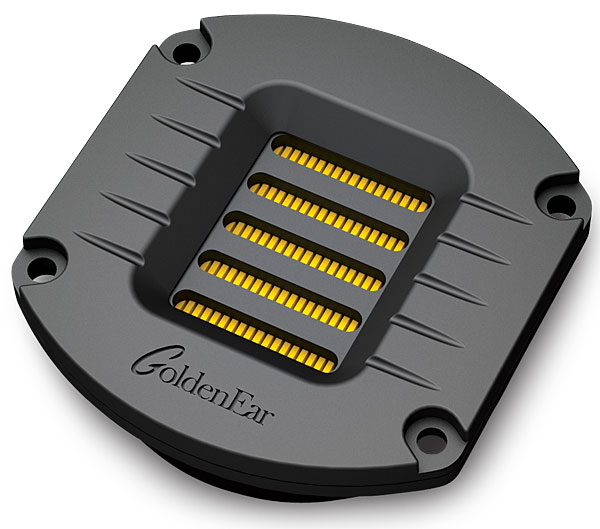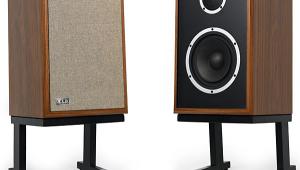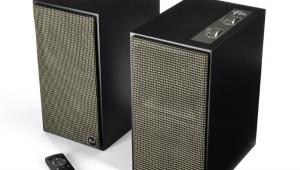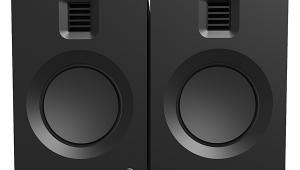GoldenEar SuperCinema 3 Speaker System Page 2
The Human Element
The human voice continues to fascinate me as one of the most compelling elements of a movie soundtrack. In Disgrace, John Malkovich superimposes a noticeably nasal tone onto his familiar instrument to bring alive a diffident yet domineering professor confronting his demons in the turbulent countryside of South Africa. The folded-diaphragm tweeters and conventional cone woofers combined to produce this obvious effect without neglecting the voice’s underlying and more subtle richness—including its correctly proportional chest resonance. Voices were intelligible even at a murmur (and the professor murmured a lot), yet the speakers achieved this without etching. Highs were extended but not exaggerated. And the vocal image in center-located dialogue remained commendably clear and tonally correct even when I sat radically off axis.

Unknown stepped up the action with Liam Neeson as a man who travels to Berlin, gets into a car crash, and awakens from a coma to find that someone has assumed his identity. The tweeters didn’t sugarcoat the brashness of the automotive mayhem (or similar scenes in other movies with more substandard soundtracks). Dream sequences were packed with pounding drums that showed off the sub’s potent bass output.
Wire in the Blood is not available on Blu-ray or in lossless surround, but I’m a huge fan of Val McDermid’s series of novels about a criminal profiler who has creepy empathy for the serial killers he stalks. So I jumped at the chance to watch the British TV series on DVD with a twochannel Dolby Digital soundtrack, using Dolby Pro Logic II Cinema to help densify dialogue in the center channel. The greater surprise was that when I cut back to the original stereo, even with relatively wide placement of the front left and right speakers, the dialogue respectably approached the same density and stability. Dialogue, music, and effects were almost ideally balanced on the SuperSats, with plenty of vividness but no discomfort-inducing edginess, demonstrating that they can be forgiving of lossy soundtracks that have been mixed with a good ear.
CD, BD, DVD-Audio
In the Stanley Clarke Trio’s Jazz in the Garden, the virtuoso fusion bassist puts aside his electric instrument for an acoustic one. He was in good company, with fellow Return to Forever alumnus Lenny White on drums and the refreshing Japanese wunderkind Hiromi on piano. The CD escaped the confines of speaker placement in either DPLII Music or stereo—a notable distinction given that, with most speakers, I find that the stereo mix often ends up speaker-bound. The GoldenEars mustered a fine team effort on the bandleader’s string bass, with its bottom end well served by the sub, its midbass fullness shouldered by the woofers, and its twang and ambience conveyed by the tweeters. The two percussion instruments—drums and piano—percussed pleasingly.

The first two symphonies of the 20th-century Polish composer Karol Szymanowski on Naxos featured Antoni Wit conducting the Warsaw Philharmonic. The SuperSats quickly revealed the relatively flat and non-reverberant character of the DTS-HD Master Audio soundtrack on this Blu-ray, but the recording’s lack of a cutting edge let me raise the volume enough to allow the Romantic-flavored symphonies to surge around the soundfield. Here the smooth character of the folded diaphragm tweeters came in handy, breathing life into this reticent recording.
King Crimson’s In the Court of the Crimson King is available in several newly reissued forms. My copy is the two-disc DVDAudio and CD package with MLP Loss-less 5.1 and DTS 5.1 soundtracks mixed by Porcupine Tree’s Steven Wilson, and MLP Lossless 2.0 and LPCM 2.0 soundtracks mixed by founding member Robert Fripp with Wilson’s help. All have resolutions of 48/24 except for the lossless stereo track, which is 96/24. As great as all these options are, the biggest improvement is that Wilson and Fripp went back to first-generation elements, eliminating the multiple generations of analog copying and recopying required to generate complex textures using the limited eight-track recording technology of the day. This audio archeology combined with the GoldenEar satellites’ high resolution to produce best-case results, turning this historic album into something even more fresh and stunning than when it was first released in 1969. It was like having a dirty window suddenly thrown wide open.

The GoldenEar Technology SuperCinema 3 is a masterfully designed product that serves music as well as it does movies. That’s no surprise given that the team at GoldenEar “have always devoted most of our time listening to music,” Gross notes on the Website. Imaging, dispersion, and rendering of sonic texture are among the satellites’ key strengths, riding above the strong foundation of the unusually shaped sub’s prodigious bass output.
While the $1,750 SuperSats are remarkably low priced for what they deliver in performance, you’ll do well to invest in the high-quality amplification recommended for them. And if you have the need to play movies at eardrum-collapsing levels, these compact little wonders may not be the best choice. But with those provisos, this is an awe-inspiringly great-sounding system, the kind that truly brings home high performance at a surprisingly low price.




























































